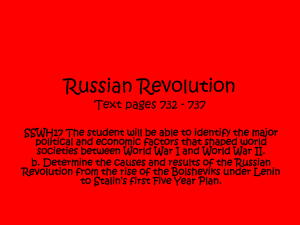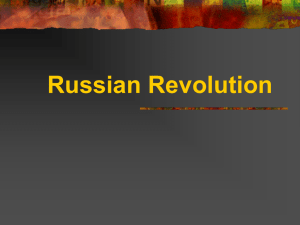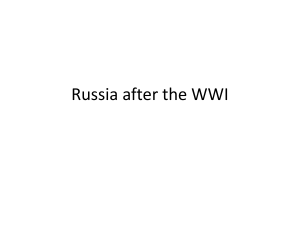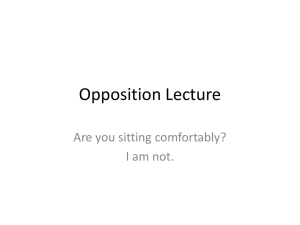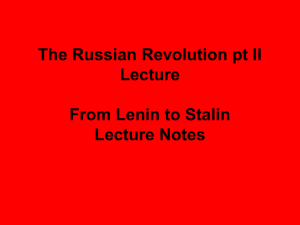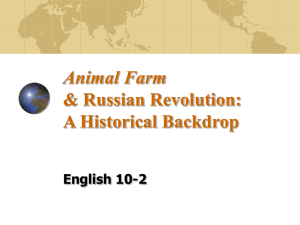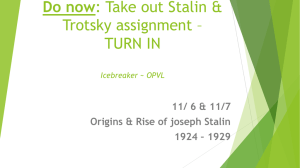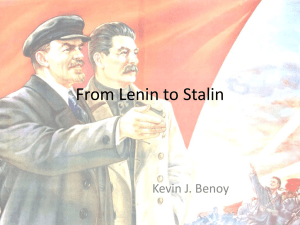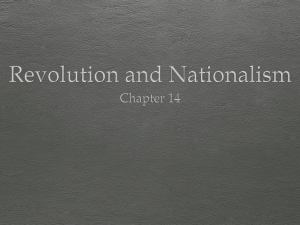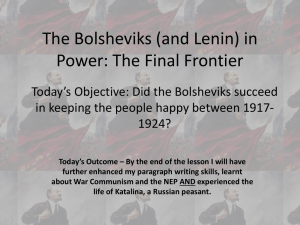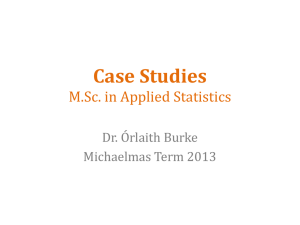Revising AS2 Russia - Lagan History Zone
advertisement
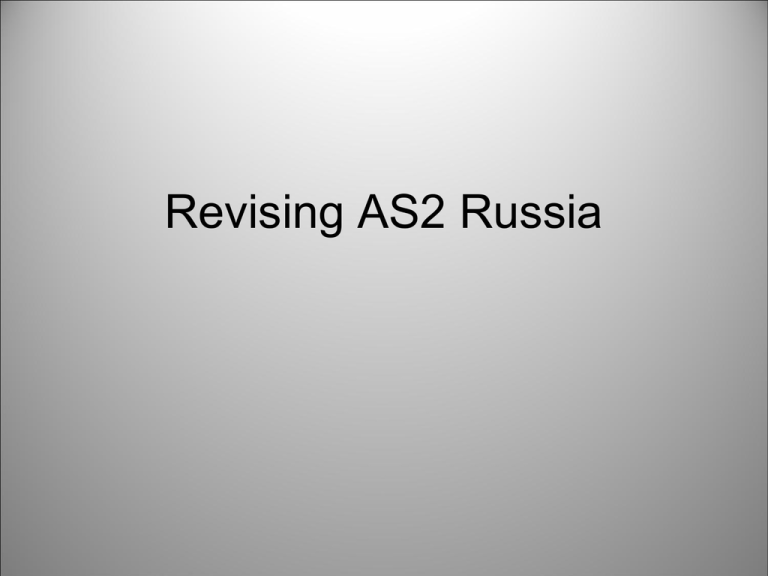
Revising AS2 Russia Using your time in the exam • • • • • • There are 4 questions to choose from You only do two of the four You must do the a) and b) parts for the question you choose Question a) = 8 marks (10 minutes) Question b) = 22 marks (30 minutes) When choosing your question – base your choice on your ability to do the 22 mark question as it has higher marks (you will always be able to get some marks for the 8 mark question even if it’s not a great answer) • Some candidates prefer to do their two 22 marks questions first – that’s perfectly fine – just make sure to clearly indicate which question you are doing The 8 mark question • • • • • • Spend about 10 minutes on this question Write 1 ½ - 2 sides max This is not an essay – so you do not need an introduction or conclusion This question is not asking you to analyse or weigh up the importance of different factors – it’s simply asking you to identify and briefly explain the key points e.g. ”what were the key features of Stalin’s cultural policies?” In this question you would explain the aims of his policies and give examples e.g. art, film, literature etc Try to cover 5 or 6 clear points, organised in paragraphs – give some explanation / supporting evidence – but this question does not require a lot of detailed analysis The potential danger with the 8 mark questions is that you might feel you have a lot to write and go over the allocated time, thus reducing the time available for the 22 marks essays – you need to be strict with yourself! The 22 mark question • • • • • • Spend 30 minutes on this question Write about 3-4 sides This is an essay so you should spend a few minutes at the start writing out a simple plan. You should have an introduction and conclusion (know your conclusion before you start writing) Use paragraphs to clearly lay out your points Read the question carefully – make sure to focus your answer on the question by referring to the key words in the question – “How successful were Stalin’s economic policies?” – the key words are ‘how successful’ – so cover the successes and the failures. “How far was Bolshevik success in October 1917 due to Lenin?” – the key words are ‘how far’ and ‘Lenin’ - look at what Lenin did and then look at the other factors in Bolshevik success Unlike the 8 mark question, this question is asking you to analyse and cover a range of factors. Look at both sides and try to back up your points with supporting evidence Break into manageable units • Background to 1905 Revolution • Immediate impact of 1905 Revolution • 1905-14 Could Tsarism survive? (strengths of Tsarism / weaknesses of opposition) • 1914-17 Short term causes of February Revolution (role of WW1 / role of Tsar / events of February) • Feb-Oct 1917 Provisional Government / October Revolution (weaknesses and mistakes of PG / strengths of Bolsheviks / actions of Lenin / actions of Trotsky) • 1918-21 Civil War (strengths of Bolsheviks / weaknesses of Whites / role of Lenin / role of Trotsky) • 1917-24 Bolshevik consolidation of power • Bolshevik economic policy 1917-24 (State Capitalism / War Communism / NEP) • Bolshevik impact on society (women / culture & arts / Orthodox Church) • Role of Lenin 1917-24 (break into 1917 and 1918-24) • Stalin’s rise to power (strengths of Stalin / mistakes of opponents – Left and Right) • Stalin’s economic policies (aims & objectives / industry – 5 Year Plans / agriculture - collectivisation / successes / failures/ gainers / losers) • Stalin’s control of the USSR (force V persuasion / purges / show trials / other forms of terror / propaganda & indoctrination / social policies / Cult of Stalin / Stalin’s Constitution) Background to 1905 Revolution • • • • • • • • • • • Long term causes … Scale of Empire / ethnic diversity Economic backwardness (agriculture / industry) Peasant anger at Redemption Dues Tsar (personality / belief in autocracy) Growth in political opposition (Liberal opposition of MCs / revolutionary opposition of SRs and SDs) Short term causes … Russo-Japanese War (military / economic impact) Economic depression / harvest failure Spark …. Bloody Sunday (Note that the protests were initially peaceful – the intention of the petitioners was to get their ‘Little Father’ to hear their complaints) Note: A question on the causes of 1905 is likely to focus on the short term causes / spark (make sure you can write about each in detail) – bring in the long term causes but don’t let them dominate your answer Immediate impact of 1905 Revolution • • • • • • October Manifesto (established the Duma) Greater freedom of speech / press (combined with growth in literacy this led to growth in criticism of the system) Fundamental Laws (shows Tsar’s lack of commitment to change) Electoral changes (gave greater representation to middle and upper classes) Stolypin’s land reforms (political & economic aims / policies / impact – successes / failures Repression (Stolypin’s necktie) • The Tsar survived because he was able to divide the opposition. He won over the MCs with the Duma and the peasants by ending Redemption Dues. This meant he could then use force to suppress the WCs and national minorities. • There was a decline in violence after 1905 but this was partly due to an improvement in the economic situation rather than support for the Tsar’s policies. The Tsar’s failure to work constructively with the Dumas combined with a decline in the economy from 1911+ led to a gradual increase in unrest, which increasingly became more politicised Russia 1905-1914 A question on this period is likely to focus on why Tsarism survived – was it due to the strengths of Tsarism or the weaknesses of opposition? – Strengths of Tsarism • Political concessions (October Manifesto / greater freedom of speech and of the press / but with limitations e.g. Fundamental Laws / electoral changes) • Stolypin’s land reforms (cover the political / economic aims) • Use of repression (Stolypin’s necktie) • Retained the loyalty of the troops • Gained from period of economic recovery – Weakness of the opposition • 1905 revolution had not been planned / participants had a mixture of economic & political aims (e.g. workers / national minorities / peasants / middle classes) • Political opponents of Tsarism between 1906 and 1914 were divided – MC liberals (wanted reform not revolution / split between Kadets and Octobrists). MCs had been horrified by the violence of 1905 and did not want a repeat – this led to divisions in the Dumas between moderates and extremists – Revolutionary opposition divided SRs v SDs / SD’s divided between Bolsheviks and Mensheviks – cover their various aims and methods While the Tsar had survived and recovered from the 1905 Revolution, had he really learnt the lessons of 1905? E.g. look at his failure to work with the 4 Dumas. 1914-17 Short term causes of February Revolution • • • Impact of the war Military impact / social impact / economic impact / political impact Role of Tsar Commander in Chief / Tsarina & Rasputin / ministerial changes / Progressive Bloc Events of February Strikes & protests / mutinies / emergences of soviets / role of army / abdication / setting up of Provisional Government • In a question asking about the causes of the February Revolution you could focus only on the period 1914-17 or you could bring in earlier long term weakness – however, the long term factors should only form a small part of the answer. • Candidates tend to be obsessed with writing about Rasputin! – remember he is just one of the factors you should cover Feb-Oct 1917 Provisional Government / October Revolution • • Weaknesses of Provisional Government Not elected so lacked legitimacy Inherited huge economic and social problems Dual Authority with Petrograd Soviet Mistakes of Provisional Government Decision to continue the war / June Offensive Delay in calling elections to Constituent Assembly / failure to deal with land issue Failure to satisfy national minorities Failure to deal with economic problems Granted freedom of speech / freed political prisoners Failure to deal decisively with the Bolsheviks after the July Days Reaction to Kornilov / release of Bolsheviks Decision to act against the Bolsheviks in October • Strengths of Bolsheviks – Role of Lenin • • • • • • – Role of Trotsky • • • • April Theses (All power to Soviets / Peace, Land, Bread – appeal to soldiers / workers / peasants) Winning over the Party Disassociating the Bolsheviks from the July Days Encouraging Bolsheviks to get involved in the Petrograd Soviet – eventually led to them getting a majority as attendance from other parties dropped Working with Trotsky to plan rising Decision to have the rising at the time the AllRussian Congress of Soviets was meeting – could then claim to be seizing power on behalf of the Soviets Supported Lenin Planned the details of the rising Organised the Red Guard and MRC Other factors – the mistakes of the SRs and Mensheviks – Joined the Provisional Government / so lost credibility with the increasingly radicalised masses 1918-21 Civil War • Strengths of Bolsheviks – Aims / unity – Geographical advantages – Strong leadership – Lenin / Trotsky – Support – Use of propaganda • Weaknesses of Whites – Aims / lack of unity – Geographical disadvantages – Weak leadership – Lack of support – Failure to appreciate importance of propaganda A good answer will have a good level of supporting evidence and will make clear comparisons between the Bolsheviks and the Whites Make sure you can write in detail about the role of Lenin and Trotsky 1917-24 Bolshevik consolidation of power • • • • • Closure of Constituent Assembly (claimed to be seizing power on behalf of the Soviets) Issuing Decrees (Land / War / Worker control – gained support) Treaty of Brest-Litovsk (to focus on civil war) Execution of Tsar (got rid of a focus for the opposition) Winning the Civil War – Strengths of Bolsheviks / weakness of opponents • Dealing with opposition outside the Party – Secret police / banning other political parties • Dealing with opposition inside the Party – Ban on factionalism • Economic policies – 1918-21 War Communism (to win Civil War) / then 1921+ NEP (to gain support and improve economy) • Social policies – Women / the Orthodox Church (also cover Islam) / Culture and the Arts (Aims: to increase control and broaden support) • Winning over national minorities – Setting up of federal system – the USSR – gave national groups a small degree of independence Bolshevik economic policy 1917-24 • State Capitalism 1917-18 (a lot of students forget about this one) – Aims (political / economic) – Policies (industry / agriculture) – Outcomes (successes / failures) • War Communism 1918-21 – Aims (political / economic) – Policies (industry / agriculture) – Outcomes (successes / failures) • New Economic Policy 1921+ – Aims (political / economic) – Policies (industry / agriculture) – Outcomes (successes / failures) Note – all 3 policies had a consistent overall aim – survival. Each policy was suited to the specific circumstances in which it was brought in. While they were different in substance they still had a common aim. All 3 were successful in some ways and a failure in others. Bolshevik impact on society • • • Religion – Aims – Policies – Outcomes (successes / failures Women & family – Aims – Policies – Outcomes (successes / failures) Culture & the Arts – Aims – Policies – Outcomes (successes / failures) Note: Bolsheviks social policies aimed to increase support and increase political control Note: Be ready for a question that asks you to assess the success (or otherwise) of the Bolsheviks in establishing control – so look for ways they succeeded and ways they met with resistance or were a failure Note: When revising, think in terms of gains and losses (Most people gained in some ways and lost out in others) Role of Lenin 1917-24 • Look carefully at the dates in the question – a question on 1918-24 is not asking you about Lenin’s role in 1917 • The role of Lenin Feb-Oct 1917 • • • • April Theses (Two key slogans: All power to Soviets / Peace, Land, Bread) Winning over doubters in the Party (Zinoviev and Kamenev) Disassociating the Bolsheviks from the July Days Encouraging Bolsheviks to get involved in the Petrograd Soviet – as attendance from other parties dropped the Bolsheviks gradually gained a majority • Working with Trotsky to plan the rising • Decision to have the rising at the time the All-Russian Congress of Soviets was meeting – so could claim to be seizing power on ‘behalf of the Soviets’ • The role of Lenin 1918-24 • • • • • • Closure of Constituent Assembly (creating one-party rule) Treaty of Brest-Litovsk with Germany (harsh terms but necessary) Support for Trotsky in Civil War (e.g. decision to restore hierarchies in the army) Economic policy (War Communism 1918-21 / NEP 1921+) Dealing with national minorities (creating a federal structure - USSR) Using terror as an instrument of policy (particularly during civil war but continued afterwards – Stalin was later able to build on this) • Dealing with opposition (banning other parties / ban on factionalism within Bolshevik Party) Stalin’s rise to power • • • • • • • • • Stalin’s personality (ruthless ambition) Key positions in the Party (e.g. Party Secretary) Use of Lenin Enrolment to increase power base (new WC members looked to Stalin as a ‘man of the people’) Capitalised on Lenin’s death (the funeral / Trotsky’s absence) Succeeded in suppressing Lenin’s Last Will and Testament Development Cult of Lenin (linked himself to Lenin’s legacy) Used Lenin’s Decree on Party Unity to suppress opposition within the Party Capitalised on divisions within the Party 1) over economic policy 2) over the future of the revolution – (these are very important so make sure to cover both) Capitalised on the weaknesses and mistakes of his opponents (Trotsky / Zinoviev / Kamenev / Bukharin) Note: A question is likely to ask you to weigh up factors e.g. How far was his rise to power due to the weaknesses of his opponents – make sure to cover other factors as well Stalin’s economic policies Policy for Industry • • • • The 5 Year Plans Aims / objectives (political / economic / military) Policies – what actually happened Successes / gainers Failures / losers Policy for Agriculture • • • • Collectivisation Aims / objectives (political / economic) Policies – what actually happened Successes / gainers Failures / losers Be prepared to describe the successes / failures of each policy (and back up with evidence) e.g. Stalin’s agricultural policy may not very been very successful in economic terms but it did help him to extend his control in the countryside by getting rid of the kulaks and other ‘rival’ symbols of authority Be prepared to make comparisons between industrial and agricultural policies – which was more successful? - they were both successful in some ways and a failure in others, though on the whole Stalin’s industrial policy was the more successful Be prepared to weigh up economic successes with the human cost – look at gains and losses. Note: despite the hardships of Stalin’s 5 Year Plans there was still a lot of enthusiasm for the transformation he was bringing about e.g. Stakhanovite movement Stalin’s control of the USSR Use of Force • The Purges – Reasons – Methods – Victims • Other methods of terror – – – – – – Secret police Informers Labour camps Unrealistic targets Passport system Punishment for absenteeism Use of Persuasion • Propaganda and Culture – – – – – – Youth organisations Education The Media Leisure & public celebrations Culture / the Arts Cult of Stalin New Soviet Constitution 1936 - What did the Constitution say? Theory v reality Be prepared for a question specifically on this Be prepared to make comparisons between the two – force v persuasion Be prepared to assess the success / failure of Stalin’s methods of control – also who gained / who lost out? Gainers and losers in Stalin’s Russia Gainers • • • • • • Less well off peasants - gained from collectivisation Communist Party members – greater opportunities to move up career ladder, special ‘perks’ Workers – rewards for meeting targets Women – greater freedom e.g. access to education and to employment (though this also had negative effect on families) Young people – youth organisations, more equal access to education Society in general – greater emphasis on equality of opportunity. Many felt they were playing a part in creating a new type of society Losers • • • • • • • • Kulaks – labelled ‘class enemies’ and ‘liquidated’ The Russian Orthodox Church – restrictions on preaching etc Workers – pressure to meet targets / punishment for absenteeism etc Political opponents – sent to labour camps or executed Families – increases in divorce, abortion and child abandonment ‘Bourgeois experts’ – tolerated under Lenin, but not under Stalin Artists and other ‘creative’ people had to follow the ‘communist’ line Society in general – restrictions on freedom of speech / potential victims of purges / indoctrination The lists above are just a selection – use your knowledge to add to them
